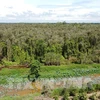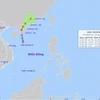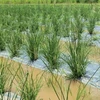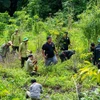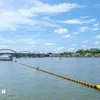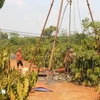Environmental pollution and climate change are worrying Vietnam, requiring new feasible solutions and growth model transfers to turn challenges into opportunities for sustainable development.
Deputy Minister of Natural Resources and Environment Nguyen Thai Lai said economic losses caused by environmental pollution account for 1.5 to 3 percent of Vietnam’s gross domestic product. Furthermore, the country spends up to 780 million USD annually on community healthcare due to the effects of pollution.
Lessons learned by developed countries reveal that nations that neglect environmental affairs during economic development will have low economic efficiency, and expenses for pollution treatment are always higher than funding required for pollution control.
Therefore, to protect the environment and actively respond to climate change, the Prime Minister approved a National Action Plan on Green Growth with the hope to establish a green economy that intensifies renewable energy use, maintains low carbon emissions, and invests in restoring the eco-system and environment.
However, Vietnam is facing significant challenges in building its green economy.
More than 70 percent of the total population are living in rural areas and depend heavily on agricultural production. Green economic development, therefore, has to be implemented in tandem with poverty reduction and social welfare policies, which require substantial capital.
Moreover, most production technologies in the country are outdated and consume excessive energy levels, but the replacement of those technologies is almost out of reach without capital and technical assistance from hi-tech countries in the world.
Revising and supplementing policies in accordance with new growth models is also a major challenge facing the country.
At the same time, the country also has big opportunities during the green economy building process. As climate change draws the attention of the international community, Vietnam is receiving support and assistance from other nations and international organisations to respond to global climate change.
According to a research by Dr Patrica from Denmark’s Copenhagen University, in Vietnam’s natural resources, cultivated land accounts for 36 percent, minerals 38 percent and other elements 26 percent. Moreover, the country has a coastline of more than 3,200 kilometres and millions of hectares of water surface.
If Vietnam is able to take advantage of its natural resources and overcome shortcomings, it will achieve its sustainable development goal, narrow the development gap and ensure political stability.
Deputy Head of the Institute of Strategy and Policy on Natural Resources and Environment Nguyen The Chinh suggested the country facilitate growth model reform with a focus on sector restructuring and with priority given to hi-tech and environmentally-friendly industries.
He emphasised the importance of improving public awareness of green economies, investing in science and technology, spending about 2 percent of the total budget expenditure on restoring the eco-system and protecting the environment, and restructuring taxes related to natural resources and the environment.-VNA
Deputy Minister of Natural Resources and Environment Nguyen Thai Lai said economic losses caused by environmental pollution account for 1.5 to 3 percent of Vietnam’s gross domestic product. Furthermore, the country spends up to 780 million USD annually on community healthcare due to the effects of pollution.
Lessons learned by developed countries reveal that nations that neglect environmental affairs during economic development will have low economic efficiency, and expenses for pollution treatment are always higher than funding required for pollution control.
Therefore, to protect the environment and actively respond to climate change, the Prime Minister approved a National Action Plan on Green Growth with the hope to establish a green economy that intensifies renewable energy use, maintains low carbon emissions, and invests in restoring the eco-system and environment.
However, Vietnam is facing significant challenges in building its green economy.
More than 70 percent of the total population are living in rural areas and depend heavily on agricultural production. Green economic development, therefore, has to be implemented in tandem with poverty reduction and social welfare policies, which require substantial capital.
Moreover, most production technologies in the country are outdated and consume excessive energy levels, but the replacement of those technologies is almost out of reach without capital and technical assistance from hi-tech countries in the world.
Revising and supplementing policies in accordance with new growth models is also a major challenge facing the country.
At the same time, the country also has big opportunities during the green economy building process. As climate change draws the attention of the international community, Vietnam is receiving support and assistance from other nations and international organisations to respond to global climate change.
According to a research by Dr Patrica from Denmark’s Copenhagen University, in Vietnam’s natural resources, cultivated land accounts for 36 percent, minerals 38 percent and other elements 26 percent. Moreover, the country has a coastline of more than 3,200 kilometres and millions of hectares of water surface.
If Vietnam is able to take advantage of its natural resources and overcome shortcomings, it will achieve its sustainable development goal, narrow the development gap and ensure political stability.
Deputy Head of the Institute of Strategy and Policy on Natural Resources and Environment Nguyen The Chinh suggested the country facilitate growth model reform with a focus on sector restructuring and with priority given to hi-tech and environmentally-friendly industries.
He emphasised the importance of improving public awareness of green economies, investing in science and technology, spending about 2 percent of the total budget expenditure on restoring the eco-system and protecting the environment, and restructuring taxes related to natural resources and the environment.-VNA
